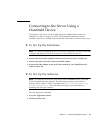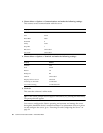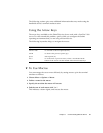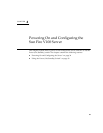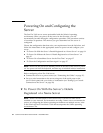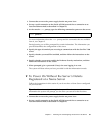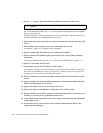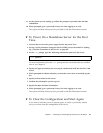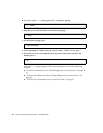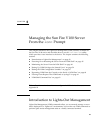
36 Sun Fire V100 Server User’s Guide • December 2001
3. At the lom> prompt, type the following command to power on the server:
For more information about the lom> prompt and the commands that are available
from it, see Chapter 5.
During booting you will be prompted for certain information. The information you
provide determines the configuration of the server.
4. Specify the type of terminal you are using to communicate with the Sun Fire V100
server.
5. When asked if you want the server to be networked, answer Yes.
If manually, specify an IP address when prompted.
6. Specify whether the IP address is to be configured by DHCP.
7. Specify which of the Ethernet ports you intend to use as the primary Ethernet
connection.
For the port labelled Net0, specify eri0. For the port labelled Net1, specify eri1.
8. Specify a host name for the server.
9. If prompted, specify the IP address for the system.
The system prompts you for this address if you declined to use DHCP in Step 6. It
also asks you whether the server is to be part of a subnet, and if you answer Yes it
prompts you to provide the netmask of the subnet.
10. Specify whether you need IPv6 enabled, and then follow the instructions on the
screen.
11. Specify whether you want to enable the Kerberos Security mechanism, and then
follow the instructions on the screen.
12. Specify the name service you want the server to use.
13. Specify the name of the domain of which the server will be a part.
14. Specify whether you want the system to search the network for a name server or
whether you want it to use a particular name server.
15. If you chose to use a particular name server, specify the host name and IP address
of the name server.
16. At the name server, create entries in the network administration files for the
system you are setting up.
lom> poweron




